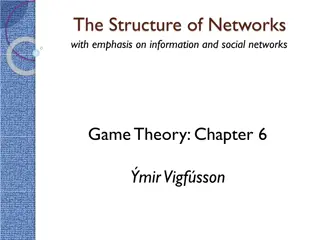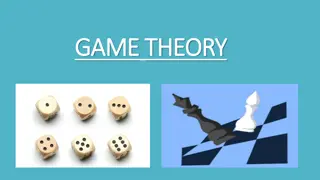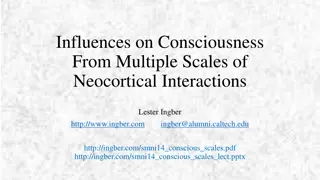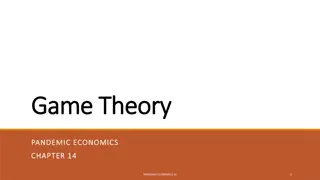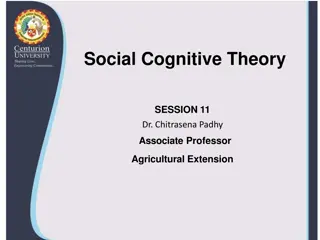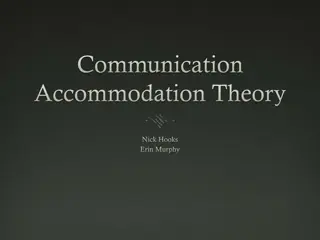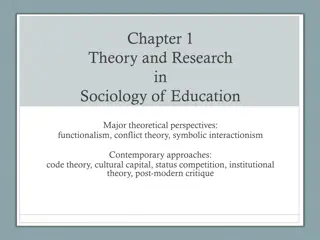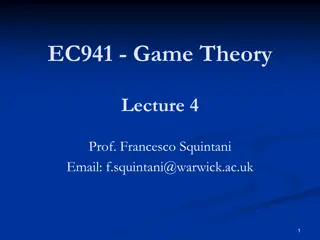Understanding Social Interactions and Game Theory
Explore the concept of interdependent choices in social interactions, where preferences can depend on the choices of others. Discover how game theory provides insights into decision-making when preferences are influenced by collective choices. Learn about the importance of societal goals and the invisible hand in ensuring favorable outcomes. Consider examples like congestion, infectious diseases, and individual vs. social objectives to understand the complexities of decision-making in various scenarios.
Download Presentation

Please find below an Image/Link to download the presentation.
The content on the website is provided AS IS for your information and personal use only. It may not be sold, licensed, or shared on other websites without obtaining consent from the author. Download presentation by click this link. If you encounter any issues during the download, it is possible that the publisher has removed the file from their server.
E N D
Presentation Transcript
Lecture4: Socialinteractionsand elementsof gametheory Juuso V lim ki September 23, 2021
This lecture: interdependent choice Last lecture: choice does not depend on others Your preferences over consumption and free time do not depend on choices of others We did not (yet) talk about the effect of others choices on wages and prices (or we fixed the behavior of others) Next: preferences may depend on the choices of others? When is this relevant? Free time is valuable only if your partner has also free time Your preferences on consumption depend on the consumption of others (keeping up with the Joneses, conspicuous consumption, virtue signaling) Infectious diseases: probability if getting infected at movies depends on others wearing masks, distancing, hygiene, Other examples: congestion (on roads, telecommunication etc.), vaccination, coordination,
Basic method: game theory At least two decision makers The feasible set of choices (for each decision maker) does not depend on what others choose Preferences over collective choices (i.e. my preference depends on my own choice, but also on the choice of all others) Each player chooses the best option for herself What does this mean when preferences depend on the choice of others? Sometimes the best choice does not depend on what the others do Sometimes the best choice varies with other decision makers choices Language of game theory: Decision makers called players, players choose actions, collective choices are called profiles of actions.
Main lessons Incredibly versatile tool to model social interactions All the examples above fit in this E.g. you can choose which road to take from A to B regardless of what others do The time to get from A to B depends on choices by others if the roads can get congested (example on board ) Individual versus social goals If all players pursue their individual preferences (or goals), are the resulting choices good from the societal point of view? What could we mean by societal goals? Adam Smith: In competitive settings, market mechanism is the invisible hand that guarantees good societal outcomes In general, not necessarily true: examples of social dilemmas Hence there is a need to think about institutions that guarantee good outcomes for the society
Interactions, strategies and games Social interaction players choices affect own outcomes and outcomes for others Strategic interaction anticipating the effects of own choices on others and of others choices on own outcomes Strategy plan of action for all possible situations Game = a model of strategic interactions in this course, only the simplest types of games covered in later courses, games with time, uncertainty (e.g. chess, poker, ) and applications to more complex situations such as pricing and bidding in auctions etc.
Example of a game: barley or hops If Ann chooses barley while Bob chooses hops, they both make 20,000. Ann ja Bob choose whether to farm barley or hops for sale in the local market place They decide simultaneously - Ann s land is better suited for hops, Bob s for barley If they choose the same crops, prices fall and they make less Game matrix: profits depending on choice (Ann chooses row, Bob chooses column) Bob Barley Hops Barley 1 2 Ann Hops 4 3 If bpth choose hops, Ann makes 30,000 while Bob makes 10,000.
Example of a game: barley or hops More precisely: 1. Players: Ann, Bob 2. Strategy of each player: barley, hops 3. Information: simultaneous choice: neither knows what the other chose 4. Outcomes: profile of choices 5. Payoffs: preferences on outcomes (higher number indicates higher preference) How would you play the game? Bob Barley Hops Barley 1 2 Ann Hops 4 3
How to think about the payoffs: steal or don t steal In this game: 1. Players: Ann, Bob 2. Strategy of each player: steal 5 from the other player 3. Information: simultaneous choice: neither knows what the other chose 4. Outcomes: profile of choices 5. Payoffs: what should we write in the matrix Bob steal don t steal Ann don t
How to think about payoffs: steal or dont Monetary payoffs in this game Suppose each player has 10 at the beginning If you steal 5 from the other player (and the other does not), you end up with 15 If the other player steals from you and you don t, you end up with 5 If both steal or if neither steals you end up with 10
Monetary preferences in the game Should we write these numbers in the matrix? Yes, if you are a psychopath and do not mind stealing from others or being stolen from No, if you care about not stealing and we want to predict behavior in this game Subjective payoffs We should really be interested in how you feel about outcomes (don t,don t),(steal,don t), (don t,steal),(steal,steal). Bob steal don t steal 10 15 Ann don t 5 10
Subjective preferencesin the game Meaning of the payoffs: These are no longer monetary numbers The number in the matrix reflects your feelings regarding your final money holdings and stealing (own strategy first, the other player s second) A higher number means only that the outcome is better Hence the numbers indicate that (don t,don t) is the best outcome. Also (don t, steal) is better than (steal,don t) indicating that guilt is a strong feeling Bob steal don t steal 3 1 Ann don t 2 4
How to think about payoffs From now on, the numbers in the payoff matrix represent the subjective payoffs Each player simply tries to get as high a payoff as possible given what the other player chooses As a result, each player must contemplate what is her best strategy for each strategy of the other player It is easy to know what to do if own best strategy does not depend on the choice of the other player If the best strategy depends on what the other player does, there is a need to predict the strategy of the other player This is the core strategic aspect of social interactions What outcomes would you expect to see in the stealing game?
Back to barley or hops: monetary payoffs coincide with subjectivepayoffs Consider first the case where Bob chooses barley What if Bob chooses hops? What is Ann s best strategy? If Bob chooses barley, Ann shoud choose hops If Bob chooses hops, Ann should choose hops What should Bob choose? If Ann chosses barley, Bob should choose hops If Ann chooses hops, Bob should choose hops Bob barley hops barley 1 2 Ann hops 4 3 Ann should always choose hops, Bob should always choose barley -> we say that hops is a dominant strategy for Ann and barley s a dominant strategy for Bob and that strategy profile (hops,barley) is the solution to the game
Best response and a dominant strategy Best response the strategy that yields the best outcome for a given strategy by the other player - E.g. Ann s best response to barley by Bob is hops Dominant strategy best response does not depend on the strategy of the other player - E.g. Ann s best strategy is hops regardless of what Bob chooses games do not always have dominant strategies Equilibrium in dominant strategies the outcome where all players choose their dominant strategy - Since dominant strategies do not always exist, not all games have dominant strategy equilibria - If they have one, it is reasonable to predict that the outcome in the game coincides with the dominant strategy equilibrium
Nash equilibrium Both players choose a best response to the strategy of the other player nobody wants to change her own strategy - Any equilibrium in dominant strategies is a Nash equilibrium but not vice versa A game can have multiple Nash equilibria some equilibria may be bad and it is also possible that the game has a single Nash equilibrium but it is not a good social outcome (we ll see examples) Not all games have Nash equilibria of the type above, but in second and third year courses, we ll see how to deal with this
Coordination games: no dominant strategies and two Nash equilibria Driving left or right If Ann and Bob choose the same side of the road, no accidents If they choose different sides, a collision results No dominant strategies Ann wants to choose the same as Bob (both want to coordinate) Now we have two Nash equilibria England: (left,left) Finland: (right,right) In a new country, how to choose? Bob left right left 1 0 Ann right 0 1
Coordination games: no dominant strategies and two Nash equilibria Stag hunt If Ann and Bob choose to hunt for a stag, they succeed If one of them chooses to catch a hare, the stag escapes If both choose to catch a hare, they both get the hare and no stag Sharing a stag is better than catching a hare Now we have two Nash equilibria Good one: (stag,stag), bad one: (hare,hare). Which is safer for the players? Bob stag hare stag 5 0 Ann hare 4 4
Barley and hops as a coordination game Same game as before but: If Ann and Bob choose the same crop, price falls so much that they both make a loss Now we have two Nash equilibria If both choose different crops, neither wants to change Notice that the inefficient outcome (barley,hops) is now a Nash equilibrium Why do we say this is inefficient? Both would be strictly better off at (hops,barley) Why is this a coordination game? Bob barley hops barley -1 2 Ann hops 4 -1
Climate control: an example of a social dilemma 1. Players: EU and US 2. Possible strategies: reduce or not reduce use of fossil fuels 3. Information: simultaneous choice of strategy 4. Oucomes: (reduce,reduce), (reduce,not),(not,reduce), (not,not). 5. Payoffs: as in the matrix. Reducing costs 3 and brings savings from smaller climate damages worth 2 to each player. Unfortunately both players have a dominant strategy not to reduce even though both would gain by moving to (reduce,reduce) EU reduce not reduce 1 -1 US not 0 2
Penalty kicks: game with no Nash equilibria 1. 2. 3. Information: simultaneous choice 4. Outcomes: (left,left),(right,left),(left,right), (right,right) 5. Payoffs: goalie saves and wins if same choice, striker scores and wins otherwise Clearly no Nash equilibria: each player wants fool the other Players:goalie and striker Possible strategies: left, right striker left right left 1 -1 goalie right -1 1
How far can we take this? We can have as many strategies as we want for each player we just have to draw bigger matrices how would you draw the matrix and payoffs for Rock-Paper- Scissors? actually we could even have the set of strategies to be the positive real numbers etc. Of course we cannot draw the matrix then but we still define payoffs as functions of strategy choices We can have more than two players again in this case, cannot draw matrices, but the analysis is still similar In more advanced courses, we introduce different timing this requires a more complicated notion of strategy Games are used also outside economics political science, biology etc.
Summary Games as representations of social interactions players, strategies, outcomes, payoffs Monetary or subjective payoffs? we could have other objective payoffs (in biological contexts, number of offspring from a given profile of behaviors) Solutions by dominant strategies very compelling if such strategies exist Nash equilibrium no incentive to change own strategy for fixed strategy of others Social dilemmas Individual incentives lead to bad social outcomes
Next lecture We return to the case of social dilemmas divergence of social and individual goals we go over a number of examples on this discuss potential solutions to social dilemmas We look at the simplest games where players do not choose their strategies simultaneously A first encounter with backward induction We also look at how to determine preferences from experimental evidence a perspective on other regarding preferences









